Atlantic Canada's Urban Growth Agenda - Greater Halifax Partnership
Atlantic Canada's Urban Growth Agenda - Greater Halifax Partnership
Atlantic Canada's Urban Growth Agenda - Greater Halifax Partnership
Create successful ePaper yourself
Turn your PDF publications into a flip-book with our unique Google optimized e-Paper software.
• A central inventory of federally owned lands and buildings, their current and future use that could have the<br />
potential for strategic urban redevelopment; and<br />
• Removal or reduction of the capital gains tax on the restoration, preservation and adaptive reuse of heritage<br />
buildings.<br />
They also recommended that the National Sustainable Infrastructure Program have specific criteria,<br />
performance measurements, rigorous evaluation and monitoring of all projects funded under this program. The<br />
recommendations are currently under consideration and expected to be part of a formal national urban agenda in the<br />
future.<br />
5.2 Social Issues<br />
Another key thrust of the national urban agenda involves the social health of Canadian cities. There is increasing<br />
pressure on social infrastructure within Canada’s largest cities. Affordable housing, better integration of immigrants,<br />
safe, accessible public spaces and environmentally-sustainable development.<br />
5.3 Governance/Leadership<br />
A key finding of the research relates to the issues of governance and leadership in the large urban areas in Canada.<br />
Many of the new challenges facing municipalities are still formally provincial responsibilities (or joint) but the<br />
municipalities are funding an increasing share and as they are becoming ‘urban’ issues (i.e. environmental, housing,<br />
etc.) the pressure on the municipal level of government is increasing.<br />
5.3.1 The fiscal imbalance<br />
One of the interesting findings of the research relates<br />
to the so-called fiscal imbalance between the federal,<br />
provincial and local levels of government.<br />
Municipalities incur significant costs associated with<br />
development (such as new infrastructure and<br />
increased local services). The greater the<br />
development the greater the costs incurred by the<br />
municipality. At the same time, the revenue derived<br />
from property taxes and other sources does not<br />
increase proportionately to the required investment in<br />
new infrastructure and services.<br />
61.0%<br />
The City of Winnipeg recently completed an analysis 29.0%<br />
of incremental tax revenue associated with economic<br />
growth in the City from 1995 to 2001. This analysis<br />
determined that the three main sources of tax<br />
revenue for the federal and provincial governments<br />
(personal income tax, corporate income tax and<br />
sales tax) grew strongly during that time frame while<br />
property tax revenue to the City actually declined by<br />
13% (adjusted for inflation) (Figure 13). Winnipeg’s<br />
conclusion was that without a new tax distribution<br />
formula, the city has no incentive to support development in the community.<br />
Figure 17: Changes in Taxation Revenue: Winnipeg Example<br />
2001 compared to 1995 Adjusted for Inflation<br />
Personal<br />
Income Tax<br />
Federal Provincial City<br />
Corporate<br />
Income Tax<br />
40.0%<br />
GST<br />
Source: City of Winnipeg<br />
19.0%<br />
Personal<br />
Income Tax<br />
103.0%<br />
Corporate<br />
Income Tax<br />
21.0%<br />
PST<br />
-13.0%<br />
Property<br />
Tax<br />
2.0%<br />
Business Tax<br />
…<strong>Atlantic</strong> Canadian Context 31





